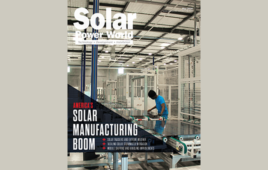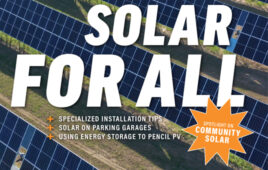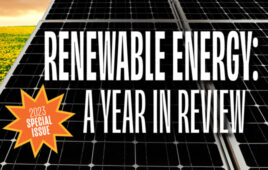 Solar Power World September 2021 Digital Edition is sponsored by CPS North America | Chint Power Global
Solar Power World September 2021 Digital Edition is sponsored by CPS North America | Chint Power Global
Solar’s role in Biden’s plan to “Build Back Better”
The Biden Administration has placed significant emphasis on its Build Back Better Agenda, a plan to create jobs, cut taxes and lower costs for working families. The solar industry has an opportunity to tap into that message while combatting climate change and shoring up domestic supply chains — two more equally large points of concern for the country. It’s time to bring back manufacturing jobs to the U.S. solar market.
I was at the ground-breaking event in August for First Solar’s third manufacturing facility in Northwest Ohio. This expansion is expected to support 700 new jobs, something Secretary of Labor Marty Walsh praised in his address to the crowd. Many other government officials and First Solar representatives spoke, often commenting on how these new jobs will help America compete directly with China for manufacturing prowess, but that the United States will treat its workers with dignity and respect — a less than subtle dig at China, in light of forced labor concerns in the Xinjiang region.
This will all make better sense once you read our review of the back-and-forth between the United States and China for solar manufacturing dominance on pg. 34. While the news of First Solar’s 700 additional jobs in U.S. panel manufacturing is great, the company makes thin-film panels, not the industry-standard crystalline silicon. There is an even larger opportunity here at home to build back our silicon solar supply chain.
All silicon solar panel manufacturers in the United States are just panel assemblers — they depend on imported silicon cells (and the wafers and ingots before them) to make completed modules. With China holding over 80% of the world’s polysilicon supply, there’s a lot the U.S. solar manufacturing industry has no control over. If the country wants to hit renewable energy targets and bring back more jobs, we have to start making all components of a solar panel here at home.
A good first step: The Senate introduced a tax credit for manufacturers in the U.S. solar panel supply chain earlier this year. If passed, it could give more incentive to ingot and wafer manufacturers to set up in the country, allowing us to hop off the Chinese supply chain, combat climate change and support more jobs — in one smooth action.
All the props to First Solar for making big solar manufacturing moves. Now let’s just get the solar silicon market to follow suit.
Kelly Pickerel
Editor in Chief
kpickerel@wtwhmedia.com
@SolarKellyP
@SolarPowerWorld





HOKU went bankrupt I believe, but was trying to get a plant up in the U.S., Idaho maybe. What happened to their plant?
It never opened. https://www.idahostatejournal.com/news/local/new-plan-for-hoku-local-businessmen-propose-industrial-park-at-former-polysilicon-plant/article_660f5ee2-41be-5129-ba55-8b559b378ff0.html
As a commercial solar installer I would like to see better relations between USA and China by creating a shared technology and commodity program for PV
Currently there are zero ingot and wafer manufacturers in the US? If there are manufacturers currently. Who are the big players?
I agree. However, even if we were able to get government subsidies for the manufactirebof ingots and silicon wafers, what about the material’s used to dope the silicon to obtain the desired electrical properties for solar cells? It is my understanding that the bulk of those needed materials are also primarily located off shore. Perhaps a yeoman measure of diplomacy could be implemented so agreements and trade policies could be reached with the Chinese and other countries who have those materials in quantity. Collaboration, although difficult, may be a path to consider. It seems to me the planet has become too small to revert back to the approach of the stoic farmer who built everything, grew everything, etc. totally independent of anyone else. As Americans, that may be difficult to resort to, but as survivors, it may be a requirement.
Absolutely right Kelly. We can and must rebuild an entire US solar supply chain here, from polysilicon through cells and modules here. We have the expertise, we have first-class startups and large companies, we have the capital to support them. All we need is long-term support from the government establishing that if China is going to subsidize, exploit slave labor, and manipulate the market, we must keep out Chinese product. We cannot allow China to monopolize a critical market like renewable energy equipment and technology
There is this company REC that has a foundry that ‘has’ operated in Washington State, it appears to be Dutch owned and past articles on this plant have bragged about the capability of the plant to provide silicon crystalline and polymorphic silicon, but also product for wafers, gasses for solar PV and perhaps for IC chips. Why isn’t “this” plant running 24/7 to support the U.S. ‘need’ for silicon products used in solar PV and IC manufacturing? This company was originally constructed in Washington State to take advantage of the amount of cheap hydrogeneration of electricity. Something reeks of usury that the Government complains and yet this plant isn’t up and running?
Entity, NERC, North American Electric Reliability Corporation says most of the spare parts kept on hand for the national grid are from foreign countries like China, Russia, Italy, Spain and I’d submit, spare parts to keep the grid up should be manufactured and warehoused all within the confines of the U.S. boarders. The deeper one digs the more obvious OUR Government has allowed trade to get to the point that some of the most basic materials are available from other countries, this threatens the very National Security of this country and it’s citizens.
The cover story talks about why REC is not running. They’ve been priced out of the market.